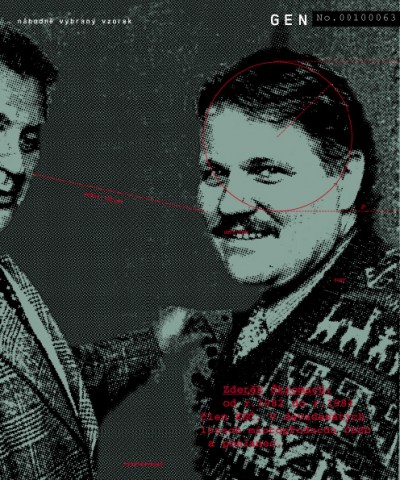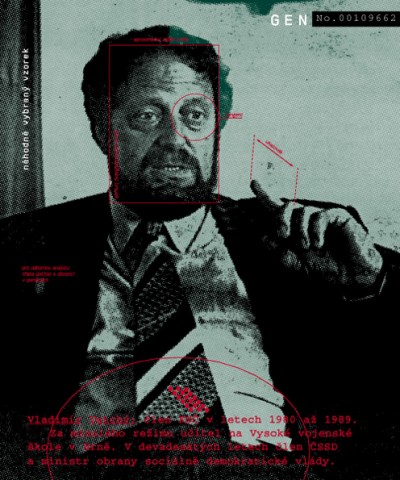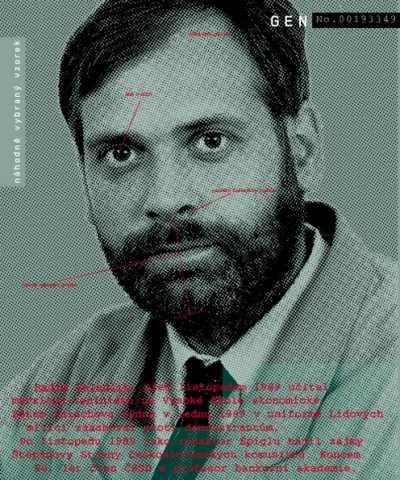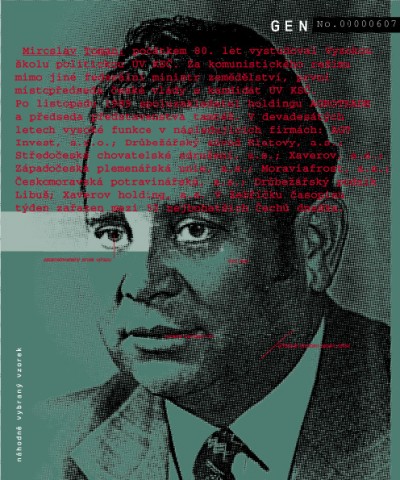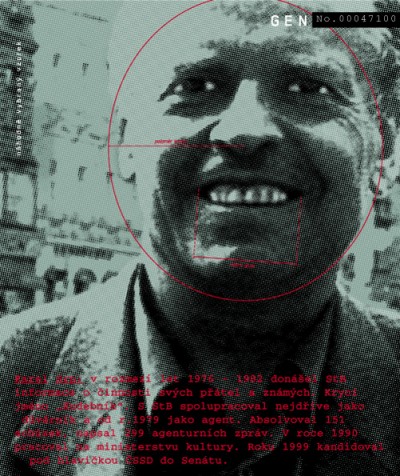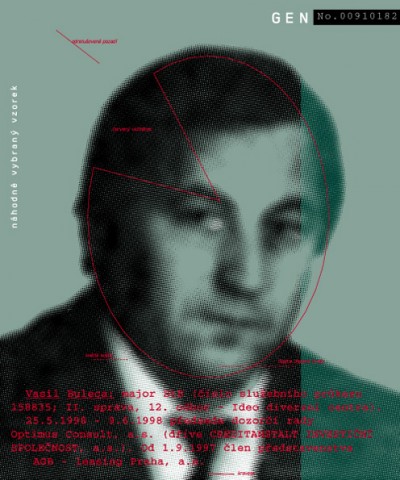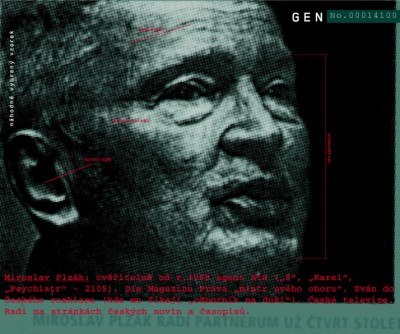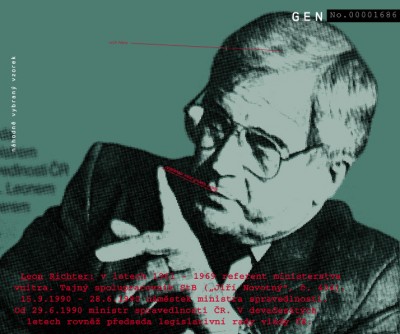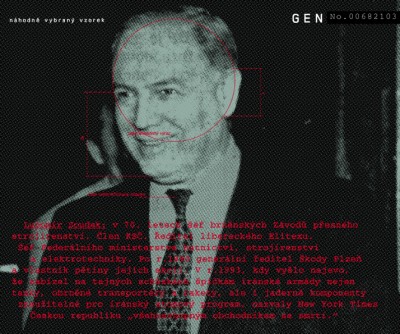MALIK URVI (GEN – Gallery of Established Nomenclature), 2000
Installation project at the Václav Špála Gallery, Prague, Czech Republic, 2000 / The project was then shown in many other Czech and Slovak galleries
The exhibition was comprised of 36 portraits of former collaborators of the Czech communist secret service (the StB), the KGB, StB officers and communist functionaries, that managed to maintain influential positions after the fall of the communist
regime in Czechoslovakia. The portraits contained short autobiographies, limited mostly to the posts and activities of the chosen individuals before and after the revolution. The exhibition generated unprecedented public attention and was the cause of many controversies in the art scene and the general media. A copy of the exhibit was commissioned by a private party, touring galleries and public spaces in the Czech Republic for several years.
Opening speech at the exhibition,
/ Ivan Medek, January 5, 2000
This exhibition is not only about these few randomly chosen samples. It’s about all of us, about our incapability to get our own society straight. The fact that these are just “randomly chosen samples” is important. If we wanted to describe these problems in detail, the space would have to be much bigger and full of many thousands of tiny pictures. But then it wouldn’t be an artist's issue, anymore. A quick glance at these exhibits makes it clear that we have to distinguish, to know that there are people among us who behaved indecently in the past but have come to realize that and now are trying to make amends. And at the same time there are those who always behaved badly, never admitted it and continue to go on in that way. Sometimes I feel like most people don’t care about this. As if that was not important. Therefore I’m glad that the people who prepared this exhibition are not indifferent and I would be happy if no one was indifferent in this country.
Exhibition text
/ Jana and Jiří·Ševčík, 1. 5. 2000
If we were to describe the feeling we had after seeing the already realized project GEN for the first time we would have to purvey the inner tension which one feels when frightened or before having to make an important decision, when one must tell the truth. This tension hasn’t left us since then and it forces us to make a certain kind of archaeology of the everyday and “cultural situations“ of the past regime. We would probably to recall the deeper experiences with art which make us think of one important question: whether art is innocent and harmless or whether it really is an effective force which can bring about change. In other words, the issue is about the concept of art itself. We consider it important in the time when – in our opinion – the ability of art to be an effective resistance power became dwarfed, when its freedom is seen in its somehow enigmatic groundlessness or when it resorts to moral responsibility to itself only. This opens a wide space of freedom for any formal experiment and art at the same time is given a protected, upholstered and isolated sphere where it’s possible to admit anything because it is only art.
Still affairs and conflicts between art and reality repeat from time to time, where suddenly the unrestrained power of art breaks through and forces the society (representatives of institutions) to act, to censor or to push art outside of real relationships. Art is traditionally eliminated by labeling its controversial displays as non-art, wherefore accountable to a different regime and punishable by law. The power of social institutions is, however, usually applied through tacit agreement of a ban, restriction on exhibiting, censorship, and so on.
We can recall the affair of Hans Haacke whose exhibition in Guggenheim was banned by the director Thomas Messer in 1971, with the explanation that it is not art, but politics, belonging elsewhere than the sacred space of a gallery. Haacke did a very laborious and factual passportization under the photographs of apartment houses which a real estate company speculated with – and discovered unpleasant power relationships. Pode Bal also did a passportization of randomly chosen power positions including data from available and disclosed sources. The artists used a non-theatrical documentary language of the technically reproduced image and message. That is nothing new, we can see similar picture and language information commonly in the newspaper and it leaves us unmoved. There, pictures function as advertisements for cigarettes with an absurd warning that smoking is harmful. But Pode Bal lifted the trivial media picture of power into the level of a visual art message and moved it into a different context – into the sacred space of exhibition halls. In there the dangerous charge – carried on the vehicle of graphic media – found itself in a space giving it a more general validity. We have to respect that the political topic is a reality as any other, just like a cup in a still life, a landscape or a figure, which an art work can use for its own ends and we suddenly perceive them in a different context where we must deal with our own moral decisions, to deal with the fact that our values are destabilized, to deal with the chaos and inner tension, and take a stand in a different way than in front of media pictures in newspapers. I think that the Pode Bal project is suddenly dangerous because it is art, and not politics, because it invaded the sacred space of the Gallery, and thus, paradoxically, as a consequence began to function in the real political space.
As we already stated, society usually reacts to such art by trying to eliminate it, for example by declaring the innocent art untouchable and saying that it is just a fictitious reality which cannot cause anything. Or it gets labeled as non-art and excluded from the sacred spaces and from society which it in fact destabilizes. We will see how our public deals with this.
Pode Bal has once again entered dangerous grounds and it must be acknowledged, that it fills a precarious gap in our art – the group makes art as critical social practice, and not as the creation of sacred products. Their projects, with a remarkable consistency and in a very short time, develop uncastrated and undifused art.
From the press / Malík Urvi
G.E.N. was to be originally exhibited in the Collection of Modern Art in Veletržní palác but it turned out that Pode Bal
is too uncomfortable for the National Gallery. Now – after the opening – G.E.N. is making even more people squirm. (The Prague Post 19. – 25. 1. 2000) The group Pode Bal opened its exhibition Malík Urvi showing photos of former Communist party functionaries and Secret Police spies who still work in important state positions. (Respekt, January 10 – 16, 2000) A flood of legal suits will probably bring on the Prague exhibition “Malík Urvi“, in which the art group Pode Bal introduces portraits of Communist officials and Secret Police collaborators. One of the first to demand an apology is the Minister of Industry, Miroslav Grégr. Another protest can be expected form the Minister Jan Kavan, others are heard as well. (Lidové noviny, January 13, 2000) “He fulfills his tasks conscientiously and readily,“ that’s the evaluation of the current foreign affairs minister Jan Kavan’s collaboration with the Secret Police by his former superior officer in a file whose fragments are made public in the Špála Gallery from January 6, 2000. (Lenka Králová, press release of Pode Bal, January 5, 2000)
It seems that with GEN and some other works, political art is returning into the Czech Republic – and that is mainly thanks to the fact that the new leaders didn’t fulfill their promise to build a prospering country on the ruins of communism. (Peter S. Green, The New York Times, May 21, 2000) A parade of the Secret Police collaborators, communist officials and traitors to any power seems scary, in spite that we are bombarded by various political affairs everyday. (Lenka Lindaurová, MF Dnes January 8, 2000) On Sunday night all the rooms of Špála Gallery were full and except of the loop with the ironic “laughter bag“ one could hear the teeth-grinding sound of the visitors. Most of the selected scoundrels are quite successful and they preside over various stock companies and managing boards. In the space one could feel a helpless question. How could we allow criminals (i.e. the caliber of captain Minařík) to escape punishment? How come the public didn’t turn its back on the discredited media types like Miroslav Plzák, Jan Cimický or Jarek Nohavica and still admires these rats? Are the voters of the social democrats so hard-skinned that they don’t mind having pre-revolution bolsheviks like Zdeněk Škromach, Pavel Mertlík in the government, not to mention Kavan’s past? (Jan Rejžek, http://iport.cz/) The exhibition Malík Urvi points to a hard-to-deny fact that the ones who profit from concealing the past of the totalitarian system the most are those who helped to keep it alive. (Rebeka Křižanová, Týden no. 4/2000) From the general political view, Pode Bal sees a great paradox between the law classifying the communist regime as criminal and the present high ranks of many of those who supported this regime actively (Petr Motyčka). Their view is a view of amazement, the amazement that many of us have long lost. (Emanuel Mandler, Lidové noviny, January 8, 2000) We are entering the dark domain, where only blurred stains stand for reality and we can only imagine, try to empathize or turn away with disgust. The performance of the group is therefore ambiguous and thus interesting. Still it evokes fear. A fear of sponsors who didn’t want to be named, a fear which was in the air during the opening. Horror societatis. (Petr Rezek, Lidové noviny, January 13, 2000) If I feared something at the exhibition of Pode Bal it wasn’t because of the courage of the artwork to provoke the powerful into reaction, it was the very impressive and smoothly elegant form of this provocation. (Marek Pokorný, Detail) Our possible uncertainty of what kind of messages they were, was clarified positively by Warhol, who made the poster an oeuvre by exhibiting it in the “format of the gallery”. The same can be seen in the work of PODE BAL. (Petr Rezek, Lidové noviny, January 13, 2000) We can easily guess that if the archives of the Ministry of the Interior were opened more than the present law allows the exhibition would not be so successful. People could find out enough information about the “randomly chosen samples” and what is important – about the consequences of their activities. Experience of the German Gauck institute, which processes and publishes the materials of the communist Stasi, show that the fear of revenge, mass murders or suicides was unfounded. But in Germany there is a much bigger social pressure than in our country. People who want to work in the state sector undergo the security checks voluntarily. Private companies are interested in the past of their employees as well. That’s why the past becomes much clearer and much less misusable than in the Czech Republic. Here it is different. We have the lustration law but that can be evaded. A typical case is Miroslav Šlouf. Thanks to his past of a high-ranking party official he cannot hold any leading function in the government bureau. But the law doesn’t speak about the head of the prime minister’s advisors. (Rebeka Křižanová, Týden 4/2000) In a speech which is enclosed in photocopies for the visitors Ivan Medek says: “If we wanted to describe these problems in detail, the space would have to be much bigger and full of many thousands of tiny pictures. But then it wouldn’t be an artists issue, anymore.“ In my opinion it could be a big state commition for artists. A communist hall of legends. (Petr Rezek, Lidové noviny, January 13, 2000) I also came to see whom the group “Fuck off” chose into the exposition of criminals and what political indecencies pulled out on them. (Eva Kantůrková, Právo, January 20, 2000) While the Špála Gallery usually yawns empty and local exhibitions attract people only during an opening, the January exhbition breaks records. (Petr Volf, Reflex no 4. 2000) Sensationalism is not a motive of this harsh exhibition. It is an appeal to our last good character traits, a need to demarcate a stable moral imperative and not to be afraid to put it into art. And so it doesn't hurt too much, the exhibition echoes with a pre-arranged laugh track. (Lenka Lindaurová, MF Dnes, January 8, 2000) If there was no other reason the exhibition “Malík Urvi” leads us at least to think of the fact that the inaccessibility of official archives can have something to do with the past of the exhibited present-day high officials (and many others of a similar kind). Such a specific collection as we can see in “Malík Urvi” calls for more contemplation. (Emanuel Mandler, Lidové noviny, January 8, 2000) The exhibition Malík Urvi whose title and photo of a hand snapping for the pinkie point to the old Czech saying “Give the devil an inch and he will take a yard” is an interactive attempt how to solve our common trauma. A part of the exhibition are reactions of the viewers who are on the basis of their experience co-creators of this revolt against an inferno. (Michal Janata, Ateliér 5/2000) Technically a rather simple procedure evokes an effect which galleries haven’t witnessed for a long time. In here art naturally merges with social critique, perforates sharply and sarcastically its mundane, intimate, “lartpoulartistic” shell and brings into the closed halls of the art scene a brilliant political provocation. (Respekt, January 10 – 16, 2000) The exhibition of Pode Bal is art. It is a ready-made of our time. Politics is reality like any other and can be reflected just like the countryside. It is only us who stopped finding topics for art in it. (Jana and Jiří Ševčíkovi, theoreticians and curators, in a survey of the magazine Umělec 1/2000) it’s naive, if not altogether prudish continuation of something that doesn’t exist anymore – in cultural dissidence. Today, when there should exist an open democratic transparency we shouldn’t need to insufficiently meddle in things that run on a different level. When it’s politics, then politics, when it’s art, then art… (Pavel Liška, director of the House of Art in Brno, in the survey of the magazine Umělec 1/2000) Pode Bal did in Špála Gallery what is the task of art: it didn’t repeat the common cliché, but with an open mind and with full personal responsibility showed what really is around us and what it is like. (Ludvík Hlaváček, theoretician, director of Foundation of Contemporary Art, in the survey of the magazine Umělec 1/2000) The lavishness of this visual construction - itself a consistent interpretation which doesn’t leave anyone in doubts about the intentions of the artists and how they distance themselves from the denounced - is another landmark in my “journey of refusal” (Marek Pokorný, Detail) Gossipers say that the members of Pode Bal are just modern followers of agitprop – the Soviet art which used propaganda and visual art for mass agitation. (Peter S. Green, The New York Times, May 21, 2000) To provoke hatred by way of a pitiful cliché through a game of art which is merely simplified propaganda strikes me as neither decent nor convenient. I feel bad when I see that we are throwing stones again. I hope that they will not admit us in the EU as we don’t have the necessary class. We are scary again. (Jaroslava Fricová, Think Magazine, 02/2000) Pode Bal brings art back to the dimension of social engagement in the best sense of the term as a co-responsibility for the moments when one can ‘not’ say ‘nothing’ to the unbearable aspects of social reality. (Michal Janata, Ateliér 5/2000) It’s the most controversial exhibition of this month, maybe of the whole year. There are loads of people in front of the exhibits which cannot be said of exhibitions of the best photographers of this day. But the visitors don’t usually come to see the beauty but the dirt. The dirt of those who play with us the everyday comedy on the highest level. (Edita Pacovská, www.grafika.cz) “Malík urvi“ is a perfectly aimed blow. A simple and clear statement of the facts with the portraits of hidden images of well-known faces (let’s hope that behind the raster they feel ashamed) without unnecessary moralizing and hystery has – as it seems – maximum effect. We must say that Pode Bal approaches the problem of intertwining the old structures into the new through critical and artistic positions. (David Kulhánek, 2000, Bazar) Medialized political and social consciousness of an artist has often a taste of something inappropriate and therefore plays in the Czech art world an important role of playful infantilism, lyricism and various forms of toothless jokes and paraphrases of popular culture. (Miloš Vojtěchovský, curator, in a survey of the magazine Umělec 1/2000) The exhibition „Malík urvi“ has a great potential which can easily turn into the form of mere gestures. Pode Bal must show that their goal is not only the effect of rippling water but also the enrichment of the discussion about moral responsibility. The purpose mustn’t be an “advertisement of the problem” only. The socially and politically engaged art holds a mirror up to society and that’s a long term strategy, which needs endurance and ability to stand up for its opinions even outside the space of the performance. We want to trust Pode Bal will manage this. (David Kulhánek, Bazar)
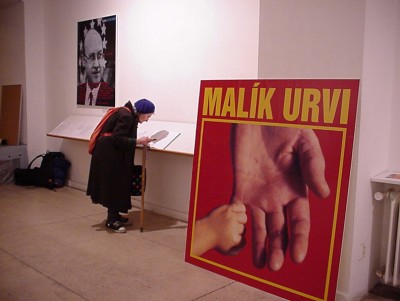
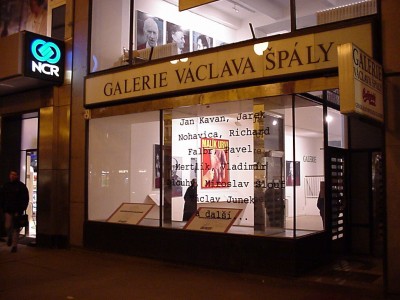
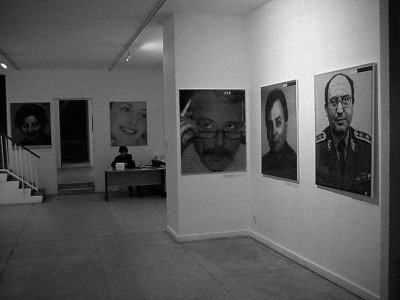
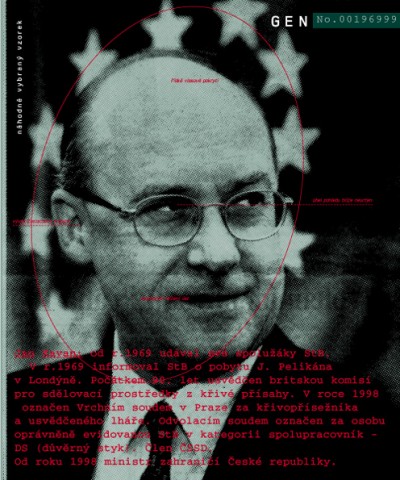
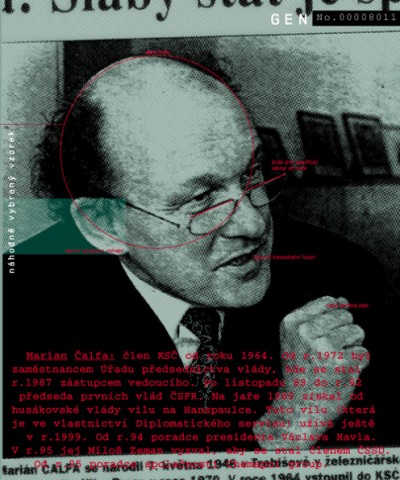
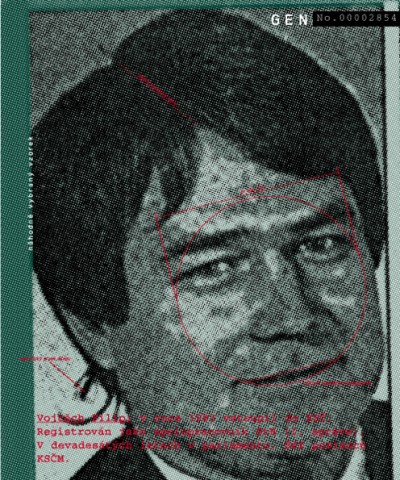
![Miroslav Šlouf: 1977–86 a member of the Board of Directors of ÚV SSM [a youth communist faction]. 1981–92 a member of the Czech National Board for KSČ. 1982–86 chairman of Czech ÚV SSM. 1988–90 chairman of ONV Prague 7. After leaving the KSČ, he became a member of ČSSD, Electoral manager of ČSSD, and the spiritual father of a successful election strategy involving a road show with the bus “Zemák“. ‘90s: President of local organization of ČSSD. A Chief Secretary in Zeman‘s cabinet. Member of ÚVV ČSSD., Cprint, 100x120 cm, 2000](https://www.podebal.com/graphics/pictures/project_263.jpg)
![VojtěchRichard Falbr: teacher at the school of the Ministry of Internal Affairs (1963–1969). Received a positive result during the screening process, confirming him as a member of the StB cadres, category A. He inspected foreign mail for the StB on the reading machine “Jezero,“ [Lake] a special patent of StB. Since 1990 he has held high posts in labour unions. Since 1994, president of Czech-Moravian chamber of OS. Vice president of ČSSD during the years 1992–93., Cprint, 100x120 cm, 2000](https://www.podebal.com/graphics/pictures/project_243.jpg)
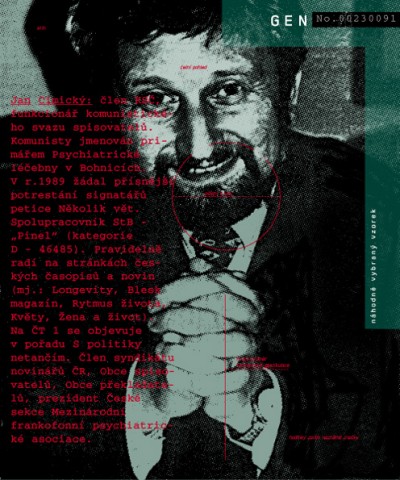
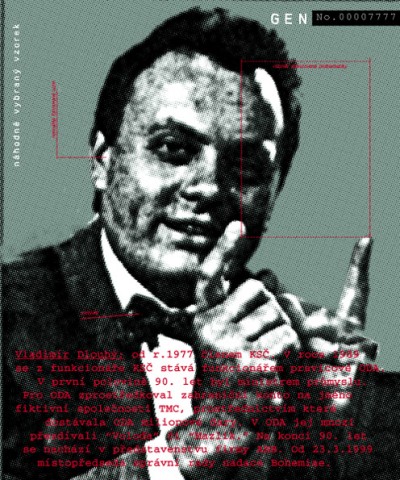
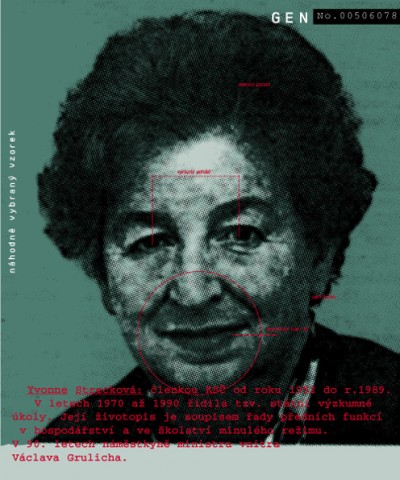
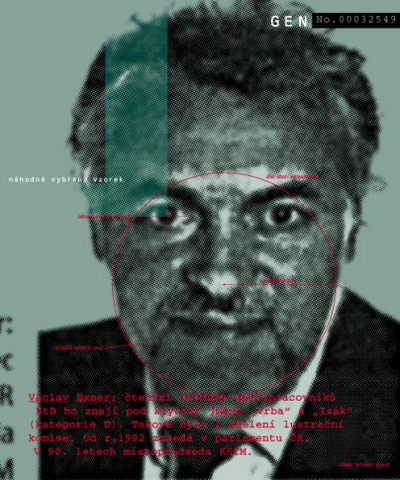
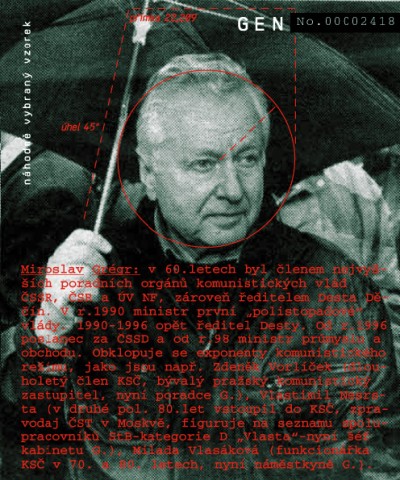
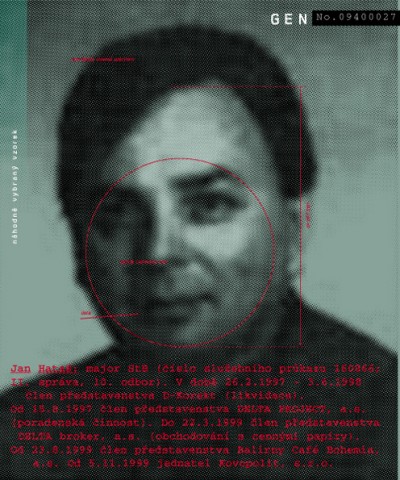
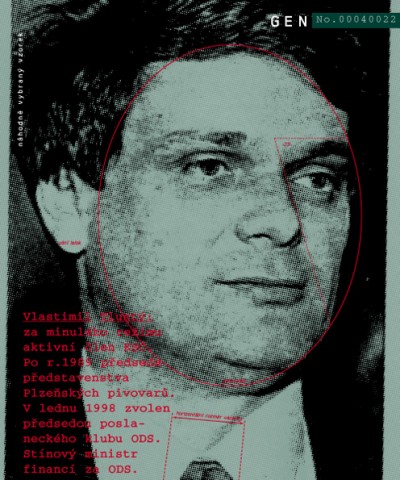
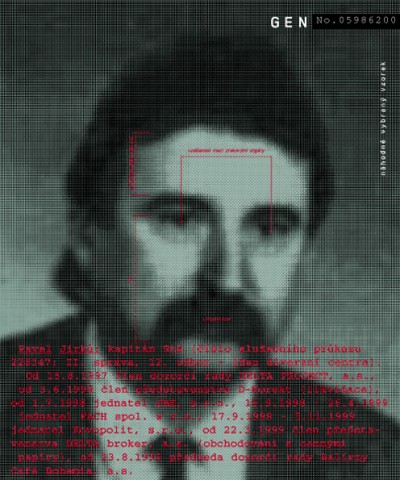
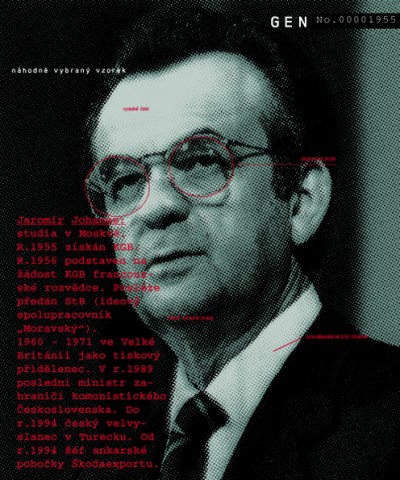
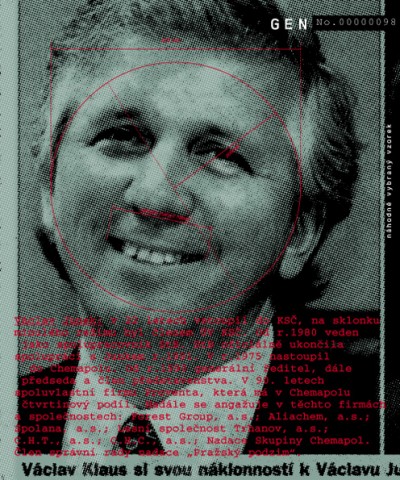
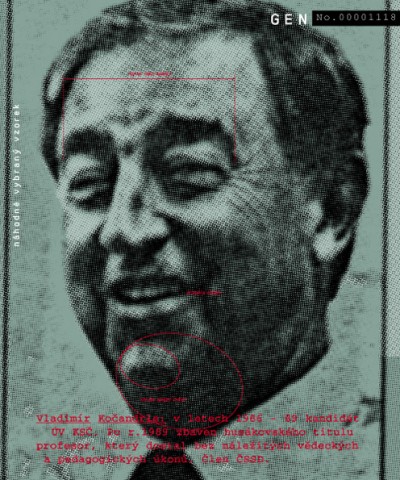
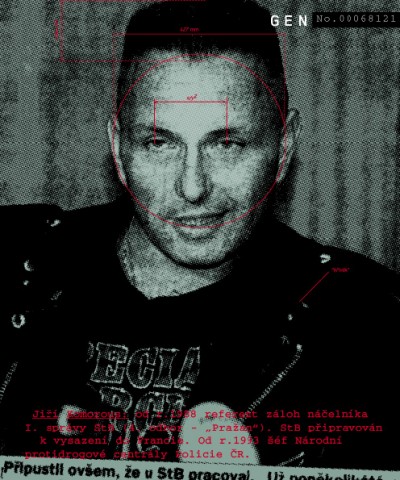
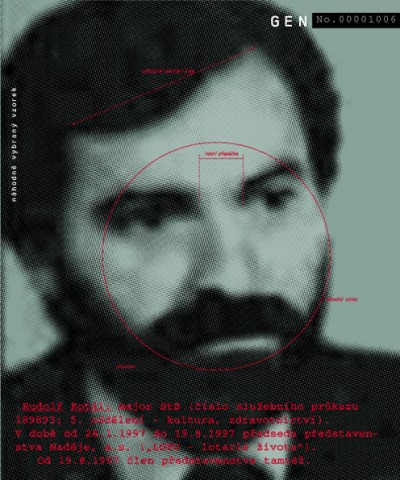
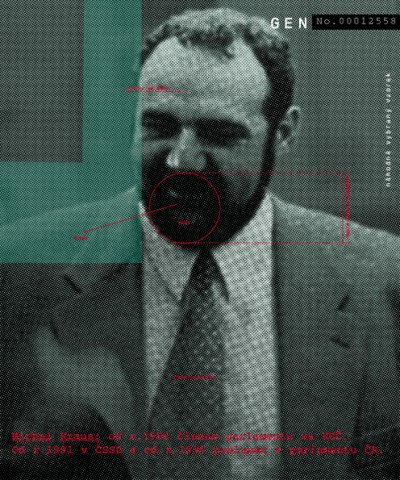
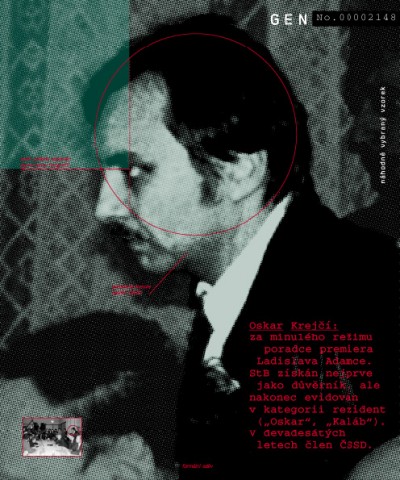
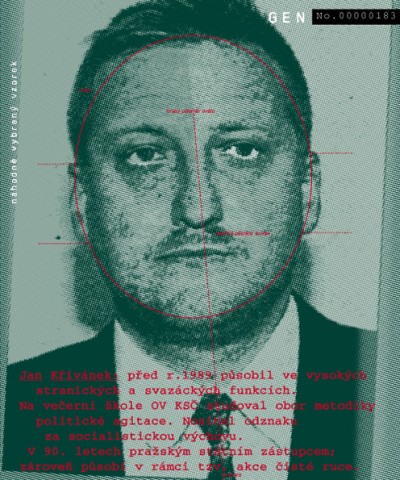
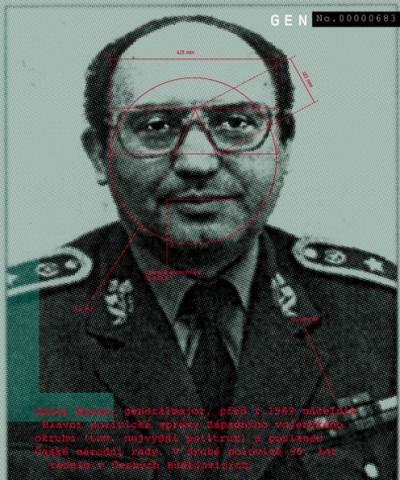

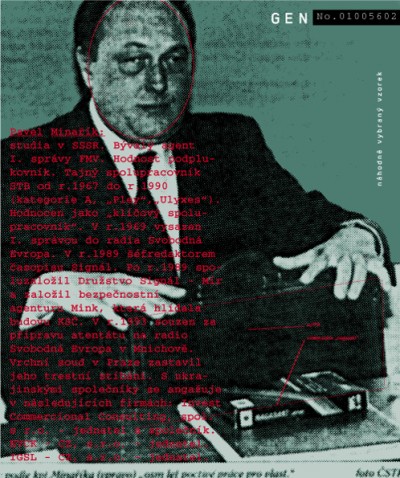
![Jaromír Nohavica: secret StB collaborator – category A – “Mirek“ (29320) [very well known Czech folk singer and poet, considered to be part of the “underground” cultural scene during the communist regime]., Cprint, 100x120 cm, 2000](https://www.podebal.com/graphics/pictures/project_261.jpg)
